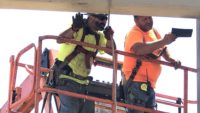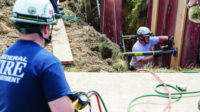Construction, among other business sectors, will be able to weigh in next month on new federal measures aimed at protecting workers from heat-related hazards.
The U.S. Labor Dept.'s Occupational Safety and Health Administration (OSHA) said it would issue in October an advance notice of proposed rulemaking to develop a workplace heat standard. Industry groups including American Road & Transportation Builders Association, Associated Builders and Contractors and National Roofing Contractors Association said they intended to participate in OSHA’s rulemaking process.
“It’s certainly something that will affect our members, as our members work year-round, including in the summer months,” said Nick Goldstein, vice president of regulatory and legal issues at ARTBA. “So it’s something the industry is going to be very interested in.”
OSHA also recently started an enforcement initiative on worker illnesses and deaths associated with hot environments. The initiative prioritizes inspections at both indoor and outdoor worksites on days when the heat index passes 80°F, or when other potential heat hazards exist.
Environmental heat exposure at work caused an average of 38 deaths per year from 2011 to 2019, said the Bureau of Labor Statistics, and officials said related deaths may be underreported. Nearly 42% of workers who died were engaged in construction, repair or cleaning. There was also an average of 2,700 heat-related cases per year during that period that resulted in days away from work.
Serious heat-related illnesses become more frequent when the heat index goes above 80°F, especially when workers are performing strenuous work, don’t have easy access to shade or water, or are not used to the climate where they’re working, according to an OSHA memo. Factors like those have even been tied to heat-related deaths on days when the heat index was below 80°F.
Groups like ARTBA and ABC already provide guidance to their members to inform them about hazards related to harsh weather conditions, and about measures they can use to protect employees.
“Many of these measures include commonsense solutions, such as beginning work shifts earlier in the day, building in rotations and educating on proper hydration techniques,” said Greg Sizemore, ABC vice president of health, safety, environment and workforce development.
Inspectors would look for records indicating any heat-related illnesses, emergency room visits or ambulance transport, according to the memo. They could interview workers about symptoms of heat-related illnesses and look for conditions that might lead to a heat-related illness. Inspectors would also want to review employer plans to address heat exposure.
OSHA said it would encourage employers to take proactive safety measures on hot days, such as having workers take regular breaks for water and shade. The agency also wants employers to teach workers how to spot common symptoms of heat-related illnesses and what they should do when it happens.
There are some industry-developed guidelines beyond informal best practices that could help inform OSHA’s rulemaking process. The American National Standards Institute and American Society of Safety Professionals have jointly proposed their A10.50 heat stress standard for the construction and demolition workforce.
In addition to new OSHA rules, the National Advisory Committee on Occupational Safety and Health will also form a work group to look into challenges and best practices to protect workers. The group will include representatives from the public, labor groups and management — as well as new members from various industries, according to the White House.
President Joe Biden said on Sept. 20 the new worker protection measures are part of a slate of new efforts by various federal agencies to deal with extreme heat, which he tied to climate change.
“As with other weather events, extreme heat is gaining in frequency and ferocity due to climate change, threatening communities across the country," he said, adding that the National Weather Service has confirmed it "is now the leading weather-related killer in America.”
Advocates have long called on the government to create standards protecting workers from heat hazards. As ENR previously reported, a group of more than 130 organizations led by Public Citizen petitioned OSHA in 2018 to mandate rest breaks away from heat and work halts at certain levels.
A few states already have heat-related safety regulations in place for workers. A California standard applying to construction and select other industries requires workers to have access to shade whenever the temperature is higher than 80°F, with other procedures added when temperatures hit 95°F such as a mandatory buddy system and mandatory cool-down breaks every two hours.
Workplace Safety
OSHA Targets Heat Hazards With New Worksite Safety Measures

A new OSHA enforcement initiative is targeting workers' heat-related illnesses and deaths.
Photo: David McSpadden/Flickr





Post a comment to this article
Report Abusive Comment